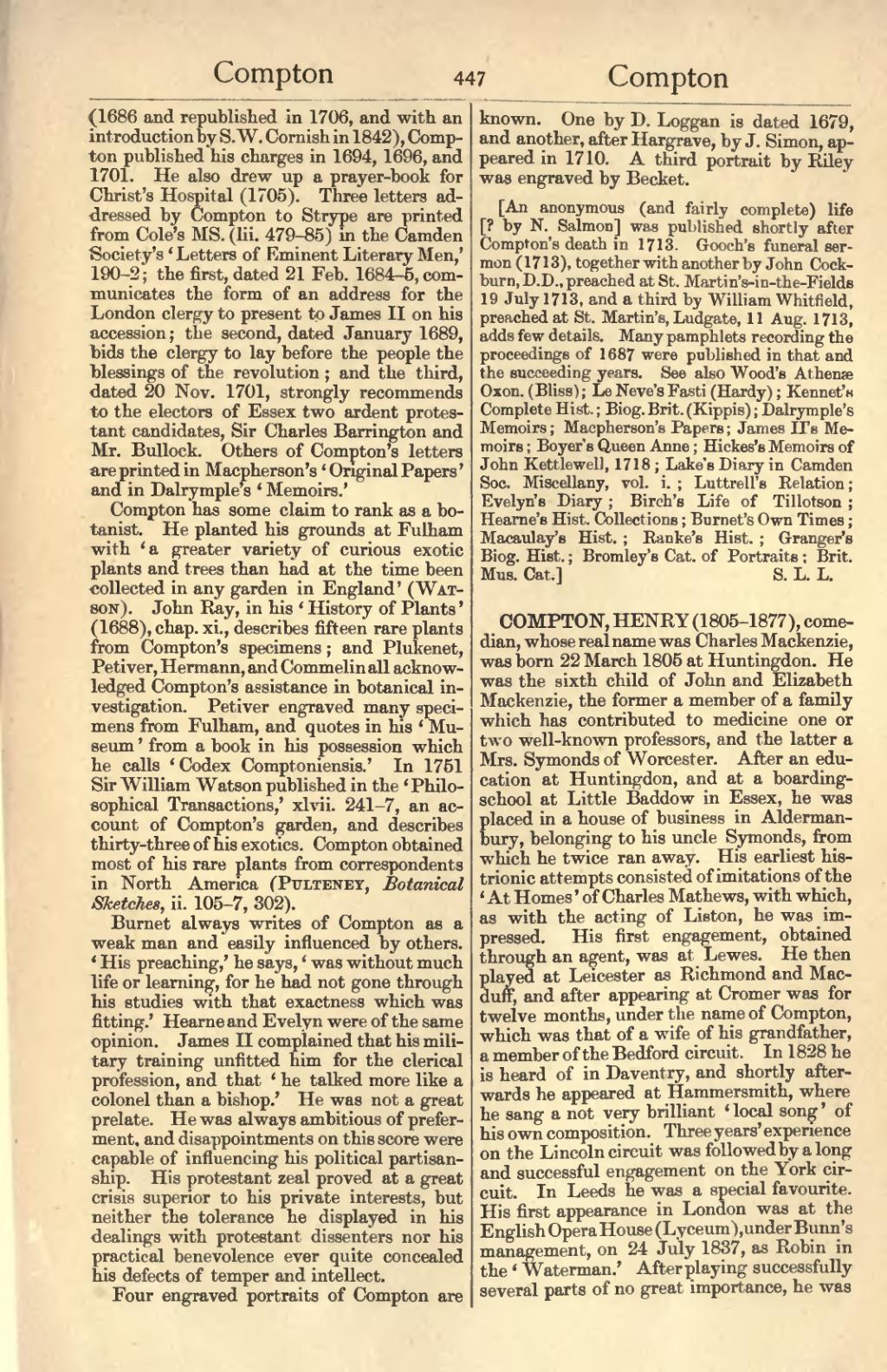(1686 and republished in 1706, and with an introduction by S. W. Cornish in 1842), Compton published his charges in 1694, 1696, and 1701. He also drew up a prayer-book for Christ's Hospital (1705). Three letters addressed by Compton to Strype are printed from Cole's MS. (lii. 479-85) in the Camden Society's 'Letters of Eminent Literary Men,' 190-2; the first, dated 21 Feb. 1684-5, communicates the form of an address for the London clergy to present to James II on his accession; the second, dated January 1689, bids the clergy to lay before the people the blessings of the revolution; and the third, dated 20 Nov. 1701, strongly recommends to the electors of Essex two ardent protestant candidates, Sir Charles Barrington and Mr. Bullock. Others of Compton's letters are printed in Macpherson's 'Original Papers' and in Dalrymple's 'Memoirs.'
Compton has some claim to rank as a botanist. He planted his grounds at Fulham with 'a greater variety of curious exotic plants and trees than had at the time been collected in any garden in England' (Watson). John Ray, in his 'History of Plants' (1688), chap, xi., describes fifteen rare plants from Compton's specimens; and Plukenet, Petiver, Hermann, and Commelin all acknowledged Compton's assistance in botanical investigation. Petiver engraved many specimens from Fulham, and quotes in his ' Museum ' from a book in his possession which he calls ' Codex Comptoniensis.' In 1761 Sir William Watson published in the 'Philosophical Transactions,' xlvii. 241-7, an account of Compton's garden, and describes thirty-three of his exotics. Compton obtained most of his rare plants from correspondents in North America (Pulteney, Botanical Sketches, ii. 105-7, 302).
Burnet always writes of Compton as a weak man and easily influenced by others. 'His preaching,' he says, 'was without much life or learning, for he had not gone through his studies with that exactness which was fitting.' Hearne and Evelyn were of the same opinion. James II complained that his military training unfitted him for the clerical profession, and that ' he talked more like a colonel than a bishop.' He was not a great prelate. He was always ambitious of preferment, and disappointments on this score were capable of influencing his political partisanship. His protestant zeal proved at a great crisis superior to his private interests, but neither the tolerance he displayed in his dealings with protestant dissenters nor his practical benevolence ever quite concealed his defects of temper and intellect.
Four engraved portraits of Compton are known. One by D. Loggan is dated 1679, and another, after Hargrave, by J. Simon, appeared in 1710. A third portrait by Eiley was engraved by Becket.
[An anonymous (and fairly complete) life [? by N. Salmon] was published shortly after Compton's death in 1713. Gooch's funeral sermon (1713), together with another by John Cockburn, D.D., preached at St. Martin's-in-the-Fields 19 July 1713, and a third by William Whitfield, preached at St. Martin's, Ludgate, 11 Aug. 1713, adds few details. Many pamphlets recording the proceedings of 1687 were published in that and the succeeding years. See also Wood's Athenæ Oxon. (Bliss); Le Neve's Fasti (Hardy); Kennet's Complete Hist.; Biog. Brit. (Kippis); Dalrymple's Memoirs; Macpherson's Papers; James II's Memoirs; Boyer's Queen Anne; Hickes's Memoirs of John Kettlewell, 1718; Lake's Diary in Camden Soc. Miscellany, vol. i.; Luttrell's Relation; Evelyn's Diary; Birch's Life of Tillotson; Hearne's Hist. Collections; Burnet's Own Times; Macaulay's Hist.; Ranke's Hist.; Granger's Biog. Hist.; Bromley's Cat. of Portraits; Brit. Mus. Cat.]
COMPTON, HENRY (1805–1877), comedian, whose real name was Charles Mackenzie, was born 22 March 1805 at Huntingdon. He was the sixth child of John and Elizabeth Mackenzie, the former a member of a family which has contributed to medicine one or two well-known professors, and the latter a Mrs. Symonds of Worcester. After an education at Huntingdon, and at a boarding-school at Little Baddow in Essex, he was placed in a house of business in Aldermanbury, belonging to his uncle Symonds, from which he twice ran away. His earliest histrionic attempts consisted of imitations of the 'At Homes' of Charles Mathews, with which, as with the acting of Listen, he was impressed. His first engagement, obtained through an agent, was at Lewes. He then played at Leicester as Richmond and Macduff, and after appearing at Cromer was for twelve months, under the name of Compton, which was that of a wife of his grandfather, a member of the Bedford circuit . In 1828 he is heard of in Daventry, and shortly afterwards he appeared at Hammersmith, where he sang a not very brilliant 'local song' of his own composition. Three years' experience on the Lincoln circuit was followed by a long and successful engagement on the York circuit. In Leeds he was a special favourite. His first appearance in London was at the English Opera House (Lyceum), under Bunn's management, on 24 July 1837, as Robin in the 'Waterman.' After playing successfully several parts of no great importance, he was
